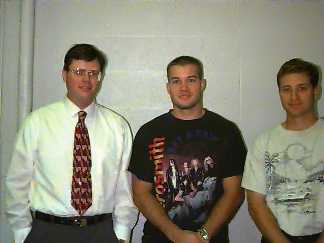Team Members | Background
| Problem Statement
Solution Procedure | Deliverables
| Company Sponsor
![]()

| David Gerstetter | James Solberg | Mark Wajda | ||
| Midlothian, IL | Ottawa, IL | Mt. Prospect, IL |
![]()
The goal of this project is to design an air intake system that would be less susceptible to plugging during snow removal applications yet be structurally capable of withstanding vibrations experienced during the snow removal operation.
![]()
Conductive Bridge
By harnessing the heat generated by the engine exhaust through a conductive
bridge connecting the exhaust stack to the engine precleaner turbine housing,
the accumulation of snow on the existing Donaldson air precleaner system
would be eliminated. Additionally the conduction of heat from the
exhaust stack to the precleaner turbine housing would prevent the turbine
blades from remaining frozen during operation after shutdown periods.
Upon further investigation into the possible solution, this solution seemed
impractical.
for a more information check out |
analysis of the conductive bridge |
Air Intake Ducked from Operator Cab
What we had initially proposed is ducting from the existing engine
air intake to the operator cab and installing an air intake receptacle
in the cab. Additionally air make-up inlets would be necessary be
required. The addition of the air inlets drawing cold air in and
passing it through the cab may lead to operator discomfort if the cab heat
exchanger were not resized for the additional air movement. The combination
of operator discomfort and the difficulty of selling existing motor grader
owners on the idea of cutting a hole in their cabs makes this a not very
feasible solution to Caterpillar's problem. Additionally, it is not
an option Caterpillar is particularly fond of due to its limited application
to the existing motor graders in service and the discomfort for the operator
generated by the additional airflow through the cab. We then concluded
that there were better solutions to the problem then this.
Air Intake from Engine Compartment
We believe an air intake inside the engine compartment is a possible
solution. The convective heat transfer from the engine block and
exhaust manifold may may be sufficient enough to melt the snow while
the inner engine compartment location would reduce the exposure of the
air intake to the weather. This option would be installed during
routine pre-plowing servicing.
Initially, we were a little reluctant to pursue this possibility because Caterpillar had already tested a similar system. Caterpillar's system took air directly in from a hole they put into the air filter. This system still allowed the air filter to become saturated. But in this system, the air never passed through the precleaner before going into the air filter.
Our Solution
Our solution to the problem was derived from the idea of the previous
possibility. This solution will still take the intake air from the
engine compartment, but it will go through a precleaner before entering
the air filter. By going through a precleaner first, any snow or
dust that is present in the engine compartment, will be ejected by the
particle separator.
It was discovered that there is a air vent on top of the engine compartment and next to the intake stack. From this vent, we plan to draw warm air through a receptacle placed on top of the vent. From this receptacle the air is ducted through flexible tubing, and is redirected by 180 degrees before it goes into the existing precleaner. Please refer to the graphical representation of the:
The receptacle is essentially an up-side-down rectangular pan which covers the vent so that the warm air over the engine can be used as intake air.
Once the prototype is fabricated, we will take it out the Caterpillar's proving grounds in Peoria, IL for testing.
![]()
Our actual deliverables is going to be a prototype of our single solutions along with an analysis on how it performed in our tests. With our conclusions Caterpillar will decide if they will market our system.
![]()

Contacts
|
Design Supervisor, Motor Grader Technical Division phone: (217) 475-4316 fax: (217) 475-4841 |
Engineer, Motor Grader Technical Division phone: (217) 475-4245 fax: (217) 475-4841 |
TOP OF PAGE | BACK to engineering credentials | BACK to engineering projects | JAMES' HOME